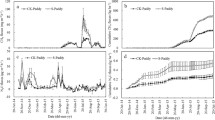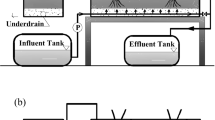Abstract
Straw application and midseason drainage play role in controlling methane (CH4) and nitrous oxide (N2O) emissions from rice paddy fields, but little information is available on their integrative effect on CH4 and N2O emissions. A two-year field experiment was conducted to study the combined effect of timing and duration of midseason aeration and wheat straw incorporation on mitigation of global warming potential (GWP) of CH4 and N2O emissions from irrigated lowland rice paddy fields. Results showed that incorporation of wheat straw increased CH4 by a factor of 5–9 under various water regimes, but simultaneously decreased N2O emission by 19–42 % during the rice growing season. Without straw incorporation, prolonged aeration significantly reduced the net 100-year GWP of CH4 and N2O emissions by 6 %, but also decreased rice production when compared with normal aeration. With straw incorporation, the lowest GWP was found by early aeration, which reduced GWP by 7 and 20 % in 2007 and 2008, respectively. Estimation of net GWPs of CH4 and N2O emissions indicated that early midseason drainage with straw incorporation offered the potential to mitigate CH4 and N2O emissions from irrigated lowland rice paddies in China.




Similar content being viewed by others
References
Aulakh MS, Wassmann R, Rennenberg H (2001) Methane emissions from rice fields—quantification, mechanisms, role of management, and mitigation options. Adv Agron 70:193–260
Baggs EM, Rees RM, Smith KA, Vinten AJA (2000) Nitrous oxide emission from soils after incorporating crop residues. Soil Use Manag 16:82–87
Baggs EM, Rees RM, Castle K, Scott A, Smith KA, Vinten AJA (2002) Nitrous oxide release from soils receiving N-rich crop residues and paper mill sludge in eastern Scotland. Agric Ecosyst Environ 90:109–123
Beauchamp E, Trevors J, Paul J (1989) Carbon sources for bacterial denitrification. Adv Soil Sci 10:113–142
Bhattacharyya P, Roy KS, Neogi S, Adhya TK, Rao KS, Manna MC (2012) Effects of rice straw and nitrogen fertilization on greenhouse gas emissions and carbon storage in tropical flooded soil planted with rice. Soil Tillage Res 124:119–130
Bhattacharyya P, Nayak AK, Mohanty S, Tripathi R, Shahid M, Kumar A, Raja R, Panda BB, Roy KS, Neogi S, Dash PK, Shukla AK, Rao KS (2013) Greenhouse gas emission in relation to labile soil C, N pools and functional microbial diversity as influenced by 39 years long-term fertilizer management in tropical rice. Soil Tillage Res 129:93–105
Cai ZC, Xing GX, Yan XY, Xu H, Tsuruta H, Yagi K, Minami K (1997) Methane and nitrous oxide emissions from rice paddy fields as affected by nitrogen fertilizers and water management. Plant Soil 196:7–14
Cai ZC, Laughlin RJ, Stevens RJ (2001) Nitrous oxide and dinitrogen emissions from soil under different water regimes and straw amendment. Chemosphere 42:113–121
Fitzgerald GJ, Scow KM, Hill JE (2000) Fallow season straw and water management effects on methane emissions in California rice. Glob Biogeochem Cycles 14(3):767–776
Flessa H, Dörsch P, Beese F, König H, Bouwman AF (1996) Influence of cattle wastes on nitrous oxide and methane fluxes in pasture land. J Environ Qual 25:1366–1370
Gao S, Tanji KK, Scardaci SC (2004) Impact of rice straw incorporation on soil redox status and sulfide toxicity. Agron J 96:70
Hadi A, Inubushi K, Yagi K (2010) Effect of water management on greenhouse gas emissions and microbial properties of paddy soils in Japan and Indonesia. Paddy Water Environ 8(4):319–324
Hao X, Chang C, Carefoot JM, Janzen HH, Ellert BH (2001) Nitrous oxide emissions from an irrigated soil as affected by fertilizer and straw management. Nutr Cycl Agroecosys 60:1–8
Huang Y, Zhang W, Zheng X, Li J, Yu Y (2004) Modeling methane emission from rice paddies with various agricultural practices. J Geophys Res 109:D08113. doi:10.1029/2003JD004401
Huang SH, Pant HK, Lu J (2007) Effects of water regimes on nitrous oxide emission from soils. Ecol Eng 31(1):9–15
Intergovernmental Panel on Climate Change (IPCC) (2007) Climate changes in atmospheric constitutes and in radioactive forcing. http://www.ipcc.ch/pdf/assessment-report/ar4/wg1/ar4-wg1-chapter2.pdf
International Rice Research Institute (IRRI) (2004) RiceStat database. Los Banos. http://www.irri.org/science/ricestat/index.asp
Itoh M, Sudo S, Mori S, Saito H, Yoshida T, Shiratori Y, Suga S, Yoshikawa N, Suzue Y, Mizukami H, Mochida T, Yagi K (2011) Mitigation of methane emissions from paddy fields by prolonging midseason drainage. Agric Ecosyst Environ 141:359–372
Jiang CS, Wang YS, Zheng XH, Zhu B, Huang Y, Hao QJ (2006) Methane and nitrous oxide emissions from three paddy rice based cultivation systems in Southwest China. Adv Atmos Sci 23:415–424
Kaiser EA, Kohrs K, Kücke M, Schnug E, Munch JC, Heinemeyer O (1998) Nitrous oxide release from arable soil: importance of perennial forage crops. Biol Fert Soils 1:36–43
Khalil MI, Inubushi K (2007) Possibilities to reduce rice straw-induced global warming potential of a sandy paddy soil by combining hydrological manipulations and urea-N fertilizations. Soil Biol Biochem 39:2675–2681
Khosa MK, Sidhu BS, Benbi DK (2010) Effect of organic materials and rice cultivars on methane emission from rice field. J Environ Biol 31:281
Khosa MK, Sidhu BS, Benbi DK (2011) Methane emissions from rice fields in relation to management of irrigation water. J Environ Biol 32:169
Kimura M, Murase J, Lu YH (2004) Carbon cycling in rice field ecosystems in the context of input, decomposition and translocation of organic materials and the fates of their end products (CO2 and CH4). Soil Biol Biochem 36(9):1399–1416
Lee CH, Park KD, Jung KY, Ali MA, Lee D, Gutierrez J, Kim PJ (2010) Effect of Chinese milk vetch (Astragalus sinicus L.) as a green manure on rice productivity and methane emission in paddy soil. Agric Ecosyst Environ 138:343–347
Li XL, Zhang GB, Xu H, Cai ZC, Yagi K (2009) Effect of timing of joint application of hydroquinone and dicyandiamide on nitrous oxide emission from irrigated lowland rice paddy field. Chemosphere 75:1417–1422
Li XL, Yuan WP, Xu H, Cai ZC, Yagi K (2011) Effect of timing and duration of midseason aeration on CH4 and N2O emissions from irrigated lowland rice paddies in China. Nutr Cycl Agroecosyst 91:293–305
Liu CY, Wang K, Meng SX, Zheng XH, Zhou ZX, Han SH, Chen DL, Yang ZP (2011) Effects of irrigation, fertilization and crop straw management on nitrous oxide and nitric oxide emissions from a wheat-maize rotation field in northern China. Agric Ecosyst Environ 140:226–233
Lou YS, Ren LX, Li ZP, Zhang TL, Kazuyuki I (2007) Effect of rice residues on carbon dioxide and nitrous oxide emissions from a paddy soil of subtropical China. Water Air Soil Poll 178:157–168
Ma J, Li XL, Xu H, Han Y, Cai ZC, Yagi K (2007) Effects of nitrogen fertilizer and wheat straw application on CH4 and N2O emissions from a paddy rice field. Aust J Soil Res 45:359–367
Ma J, Xu H, Yagi K, Cai ZC (2008) Methane emission from paddy soils as affected by wheat straw returning mode. Plant Soil 313:167–174
Ma J, Ma ED, Xu H, Yagi K, Cai ZC (2009) Wheat straw management affects CH4 and N2O emissions from rice fields. Soil Biol Biochem 41:1022–1028
Ma J, Ji Y, Zhang GB, Xu H, Yagi K (2013) Timing of midseason aeration to reduce CH4 and N2O emissions from double rice cultivation in China. Soil Sci Plant Nutr 59(1):35–45
Millar N, Baggs EM (2004) Chemical composition, or quality, of agroforestry residues influences N2O emissions after their addition to soil. Soil Biol Biochem 36:935–943
Minamikawa K, Sakai N (2006) The practical use of water management based on soil redox potential for decreasing methane emissions from a paddy field in Japan. Agric Ecosyst Environ 116:181–188
Pathak H, Singh R, Bhatia A, Jain N (2006) Recycling of rice straw to improve wheat yield and soil fertility and reduce atmospheric pollution. Paddy Water Environ 4:111–117
Patten D, Bremner J, Blackmer A (1980) Effects of drying and air-dry storage of soils on their capacity for denitrification of nitrate. Soil Sci Soc Am J 44:67–70
Shan J, Yan XY (2013) Effects of crop residue returning on nitrous oxide emissions in agricultural soils. Atmos Environ 71:170–175
Singh Y, Singh B, Ladha JK, Khind CS, Gupta RK, Meelu OP, Pasuquin E (2004) Long-term effects of organic inputs on yield and soil fertility in the rice wheat rotation. Soil Sci Soc Am J 68:845–853
Singh B, Shan YH, Johnson-Beebout SE, Singh Y, Buresh RJ (2008) Crop residue management for lowland rice-based cropping systems in Asia. Adv Agron 98:117–199
Suryavanshi P, Singh YV, Prasanna R, Bhatia A, Shivay YS (2013) Pattern of methane emission and water productivity under different methods of rice crop establishment. Paddy Water Environ 11:321–329. doi:10.1007/s10333-012-0323-5
Thangarajan R, Bolan NS, Tian GL, Naidu R, Kunhikrishnan A (2013) Role of organic amendment application on greenhouse gas emission from soil. Sci Total Environ (in press)
Wang Y, Hu C, Zhu B, Xiang H, He X (2010) Effects of wheat straw application on methane and nitrous oxide emissions from purplish paddy fields. Plant Soil Environ 56:16–22
Wang JY, Jia JX, Xiong ZQ, Khalil MAK, Xing GX (2011) Water regime–nitrogen fertilizer–straw incorporation interaction: field study on nitrous oxide emissions from a rice agroecosystem in Nanjing, China. Agric Ecosyst Environ 141:437–446
Wang JY, Zhang XL, Xiong ZQ, Khalil MAK, Zhao X, Xie YX, Xing GX (2012) Methane emissions from a rice agroecosystem in South China: effects of water regime, straw incorporation and nitrogen fertilizer. Nutr Cycl Agroecosyst 93:103–112. doi:10.1007/s10705-012-9503-3
Xiong ZQ, Xing GX, Tsuruta H, Shen GY, Shi SL, Du LJ (2002) Measurement of nitrous oxide emissions from two rice-based cropping systems in China. Nutr Cycl Agroecosyst 64:125–133
Yagi K, Tsuruta H, Kanda K, Minami K (1996) Effect of water management on methane emission from a Japanese rice paddy field: automated methane monitoring. Glob Biogeochem Cycles 10(2):255–267
Yan X, Du L, Shi S, Xing G (2000) Nitrous oxide emission from wetland rice soil as affected by the application of controlled-availability fertilizers and midseason aeration. Biol Fertil Soils 32:60–66
Yan X, Yagi K, Akiyama H, Akimoto H (2005) Statistical analysis of the major variables controlling methane emission from rice fields. Glob Chang Biol 11:1131
Yan DZ, Wang DJ, Yang LZ (2007) Long-term effect of chemical fertilizer, straw, and manure on labile organic matter fractions in a paddy soil. Biol Fert Soils 44:93–101
Yang SS, Chang HL (2001) Methane emission from paddy fields in Taiwan. Biol Fertil Soils 33:157–165
Yao ZS, Zhou ZX, Zheng XH, Xie BH, Mei BL, Wang R, Butterbach-Bahl K, Zhu JG (2010) Effects of organic matter incorporation on nitrous oxide emissions from rice-wheat rotation ecosystems in China. Plant Soil 327:315–330
Zou J, Huang Y, Jiang J, Zheng X, Sass RL (2005) A 3-year field measurement of methane and nitrous oxide emissions from rice paddies in China: effects of water regime, crop residue, and fertilizer application. Glob Biogeochem Cycles 19:GB2021
Zou J, Huang Y, Zheng X, Wang Y (2007) Quantifying direct N2O emissions in paddy fields during rice growing season in mainland China: dependence on water regime. Atmos Environ 41:8030–8042
Zou J, Huang Y, Qin Y, Liu S, Shen Q, Pan G, Lu Y, Liu Q (2009) Changes in fertilizer-induced direct N2O emissions from paddy fields during rice-growing season in China between 1950 and 1990. Glob Chang Biol 15:229–242
Acknowledgments
Funding for this research work was provided by Ministry of Science and Technology of China (2012DFG90290), Ministry of Agriculture of China (201103039), Chinese Academy of Sciences (XDA05020200), and Natural Science Foundation of China (41201331 and 41205104).
Author information
Authors and Affiliations
Corresponding authors
Rights and permissions
About this article
Cite this article
Li, X., Ma, J., Yao, Y. et al. Methane and nitrous oxide emissions from irrigated lowland rice paddies after wheat straw application and midseason aeration. Nutr Cycl Agroecosyst 100, 65–76 (2014). https://doi.org/10.1007/s10705-014-9627-8
Received:
Accepted:
Published:
Issue Date:
DOI: https://doi.org/10.1007/s10705-014-9627-8




